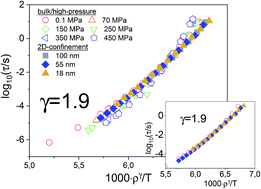Testing density scaling in nanopore-confinement for hydrogen-bonded liquid dipropylene glycol
Abstract
Recently, it has been demonstrated that the glassy dynamics of the molecular liquids and polymers confined at the nanoscale level might satisfy the density scaling law (ργ/T) with the same value of the scaling exponent, γ, as that determined from the high-pressure studies of the bulk material. In this work, we have tested the validity of this interesting experimental finding for strongly hydrogen-bonded molecular liquid, dipropylene glycol (DPG), which is known to violate the ργ/T scaling rule in the supercooled liquid bulk state. The results of the independent dielectric relaxation studies carried out on increased pressure and in nanopores, have led to an important finding that when the density change induced by geometrical confinement is not very large, DPG can still obey the density scaling law with the same value of the scaling exponent as that found for the bulk sample. In this way, we confirm that the information obtained from the universal density scaling approach applied to nanoscale confined systems is somehow consistent with the macroscopic ones and that in both cases the same fundamental rules governs the glass-transition dynamics.



 Please wait while we load your content...
Please wait while we load your content...